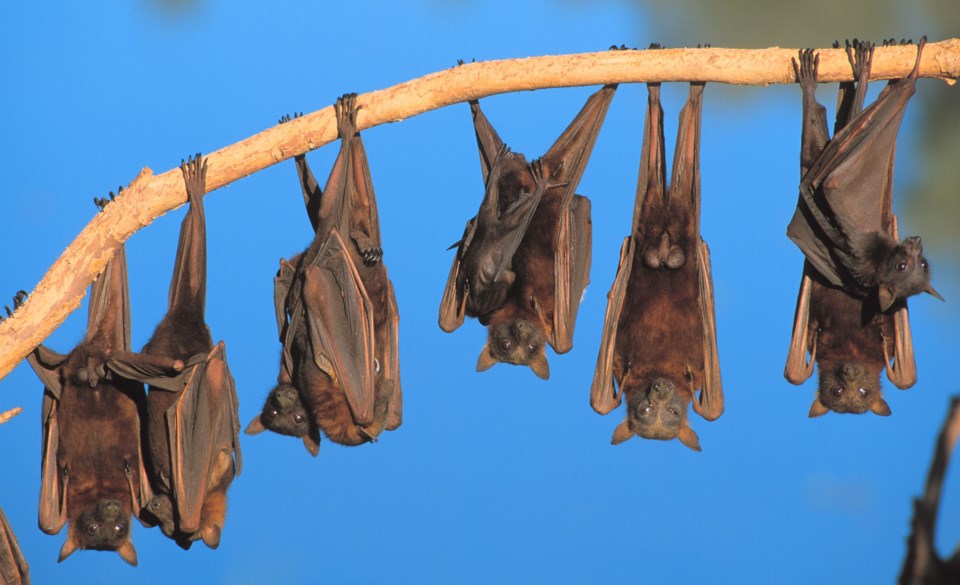Fewer bats will be flapping through the evening skies in the coming months. It’s the time of year where some species go into hibernation, .
Fortunately, this disappearance is only seasonal. Bats are critical for the functioning of healthy ecosystems. They . They also , which reduces the need for pesticides.
Bats provide enormous value to our ecosystems, but because they do their work under the cover of darkness, we aren’t always aware of the help they give.
Threatened habitats
More worrisome than this seasonal disappearance is the fact that bat populations have been . Loss of habitat due to forestry, urbanization and reduces suitable habitats for bats, while pesticide application kills the insects that they feed on.
These impacts are exacerbated by the fungus, Pseudogymnoascus destructans, which causes white-nose syndrome. This fatal fungus is responsible for .
White-nose syndrome has been particularly devastating in Eastern Canada where it’s caused of little brown myotis (Myotis lucifugus) and northern myotis (Myotis septentrionalis).
The fungus is making its way further west, with the in July. White-nose syndrome hasn’t been detected yet in British Columbia, but the deadly threat is looming.
Our research team at the B.C. node of the has been working to support wildlife health for over a decade. To understand the threats currently facing the , we studied 275 bats that had died between 2015 and 2020. We found that
This information can help us track bat populations over time and in response to urbanization and climate change. In order to help bats live, we need to know why they die.
Killer cats
A quarter of the bats in our study were killed by cats. This wasn’t surprising — domestic cats are . In Australia, free-roaming pet cats are estimated to kill 390 million animals a year.
Free-roaming cats pose not only a , but also to biodiversity. Some cities in Iceland have to save their declining bird populations.
One of our more surprising findings was that most of the bats we found that were killed by cats were female and in relatively good body condition. This greater proportion of dead female bats might be due to where female bats give birth to and raise their young.
Because bats have relatively , the death of female bats in otherwise good condition has outsized implications for their population numbers into the future.
The simplest solution here is to keep pet cats indoors and supervise outdoor cat time. Cats only bring about , so owners likely aren’t aware of the extent of their feline friends’ hunting habits.
Recent research suggests that . Cats were found to be more likely to prey on wildlife closer than 500 metres to forests rather than further away. Focusing on managing cats who live near forested areas could be one way to minimize risks to wildlife.
Keeping cats inside has benefits for cats too: Indoor cats than cats that live outside.
Worlds collide
Half of the bats in our study died by human-associated causes. That’s partly because the bats we studied were submitted to our lab by members of the public. Most of the bats in our study (90 per cent) were synanthropic species, those who live alongside people.
Reflecting these close contacts, another 25 per cent of bats in this study died due to blunt force trauma, such as through vehicle or garage door collisions.
Interestingly, bats that died in this way were more likely to be male. It’s not entirely clear why this is, but research suggests that males may , increasing their likelihood of collisions with cars or buildings.
Understanding differences in death by sex is helpful because it can inform conservation and management. For example, identifying where bats fly and how far could determine where to construct new roadways. The creation of in busy bat areas could also help reduce fatalities.
An incomplete picture
Studying wildlife isn’t easy. Bats roost in lots of different places, from caves to barns to attics, and scientists can’t monitor bats in all places at all times.
Reports from communities contribute to the information gathered about bats, and help us to understand the health of local bat populations.
To study bat mortality, we use an approach called “,” where the public is an essential research partner. Those who find sick or dead wildlife can report it online to the Canadian Wildlife Health Cooperative . In B.C. you can report bats specifically through the . You can also learn more about creating bat friendly spaces in the .
This article is based on research led by Western College of Veterinary Medicine student Imara Beattie with the British Columbia node of the Canadian Wildlife Health Cooperative.
![]()
Kaylee Byers is the Deputy Director for the British Columbia node of the Canadian Wildlife Health Cooperative.



